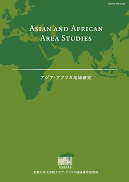Volume 1
Displaying 1-20 of 20 articles from this issue
- |<
- <
- 1
- >
- >|
On this Inaugural Issue
-
2001Volume 1 Pages 1-2
Published: March 30, 2001
Released on J-STAGE: December 05, 2018
Download PDF (102K)
A New Horizon in Area Studies
-
2001Volume 1 Pages 3-4
Published: March 30, 2001
Released on J-STAGE: December 05, 2018
Download PDF (85K) -
2001Volume 1 Pages 5-20
Published: March 30, 2001
Released on J-STAGE: December 05, 2018
Download PDF (834K) -
2001Volume 1 Pages 21-36
Published: March 30, 2001
Released on J-STAGE: December 05, 2018
Download PDF (894K) -
2001Volume 1 Pages 37-53
Published: March 30, 2001
Released on J-STAGE: December 05, 2018
Download PDF (951K) -
2001Volume 1 Pages 54-67
Published: March 30, 2001
Released on J-STAGE: December 05, 2018
Download PDF (939K) -
2001Volume 1 Pages 68-80
Published: March 30, 2001
Released on J-STAGE: December 05, 2018
Download PDF (841K) -
2001Volume 1 Pages 81-94
Published: March 30, 2001
Released on J-STAGE: December 05, 2018
Download PDF (875K) -
2001Volume 1 Pages 95-118
Published: March 30, 2001
Released on J-STAGE: December 05, 2018
Download PDF (1652K) -
2001Volume 1 Pages 119-128
Published: March 30, 2001
Released on J-STAGE: December 05, 2018
Download PDF (638K) -
2001Volume 1 Pages 129-154
Published: March 30, 2001
Released on J-STAGE: December 05, 2018
Download PDF (1741K)
Articles
-
2001Volume 1 Pages 155-185
Published: March 30, 2001
Released on J-STAGE: December 05, 2018
Download PDF (2084K) -
2001Volume 1 Pages 186-211
Published: March 30, 2001
Released on J-STAGE: December 05, 2018
Download PDF (1556K) -
2001Volume 1 Pages 212-230
Published: March 30, 2001
Released on J-STAGE: December 05, 2018
Download PDF (1038K) -
2001Volume 1 Pages 231-250
Published: March 30, 2001
Released on J-STAGE: December 05, 2018
Download PDF (1227K) -
2001Volume 1 Pages 251-276
Published: March 30, 2001
Released on J-STAGE: December 05, 2018
Download PDF (1767K) -
2001Volume 1 Pages 277-299
Published: March 30, 2001
Released on J-STAGE: December 05, 2018
Download PDF (1445K)
Research Note
-
2001Volume 1 Pages 300-307
Published: March 30, 2001
Released on J-STAGE: December 05, 2018
Download PDF (469K)
Book Reviews
-
2001Volume 1 Pages 308-319
Published: March 30, 2001
Released on J-STAGE: December 05, 2018
Download PDF (804K)
Fieldwork News
-
2001Volume 1 Pages 320-328
Published: March 30, 2001
Released on J-STAGE: December 05, 2018
Download PDF (832K)
- |<
- <
- 1
- >
- >|
